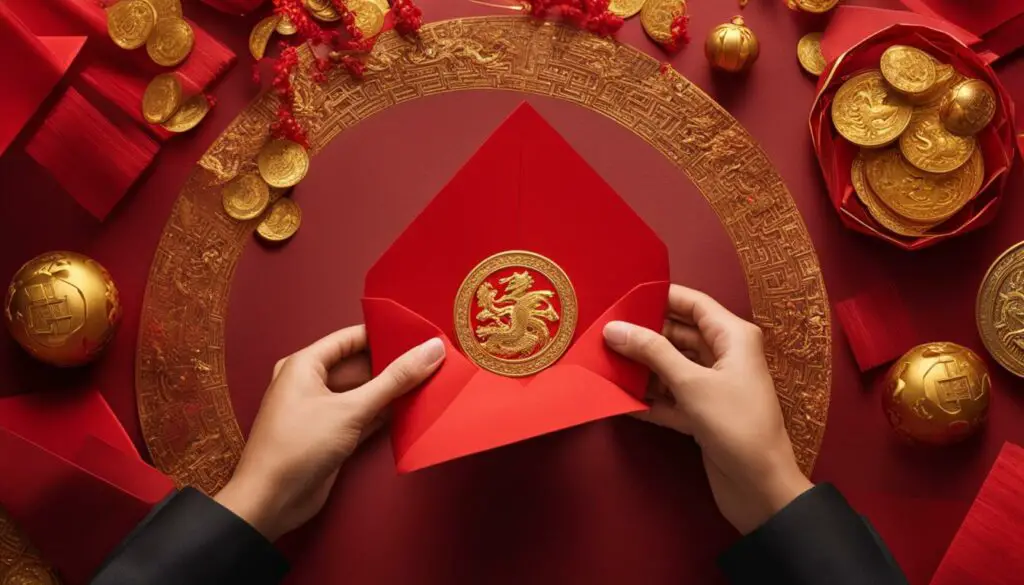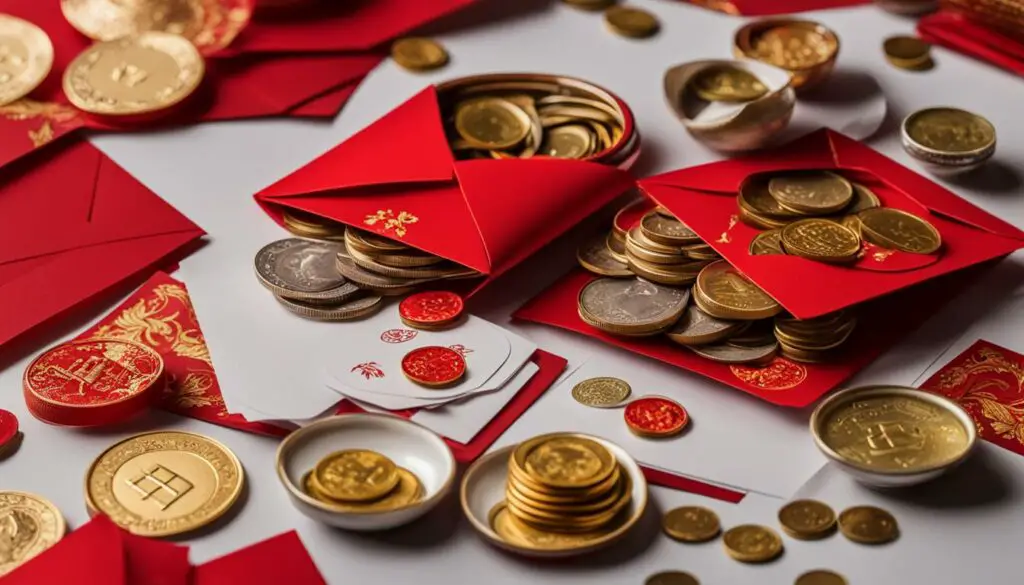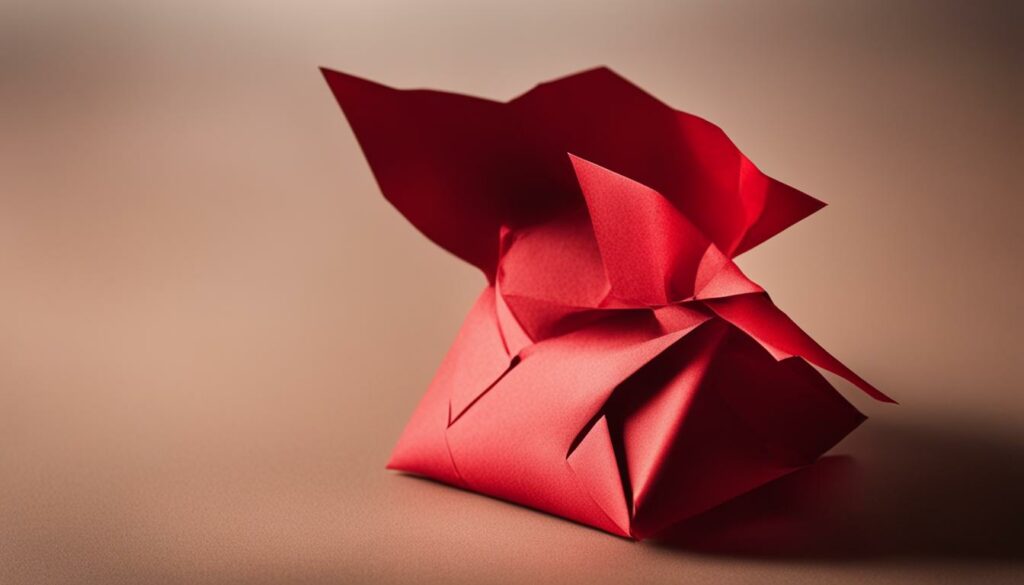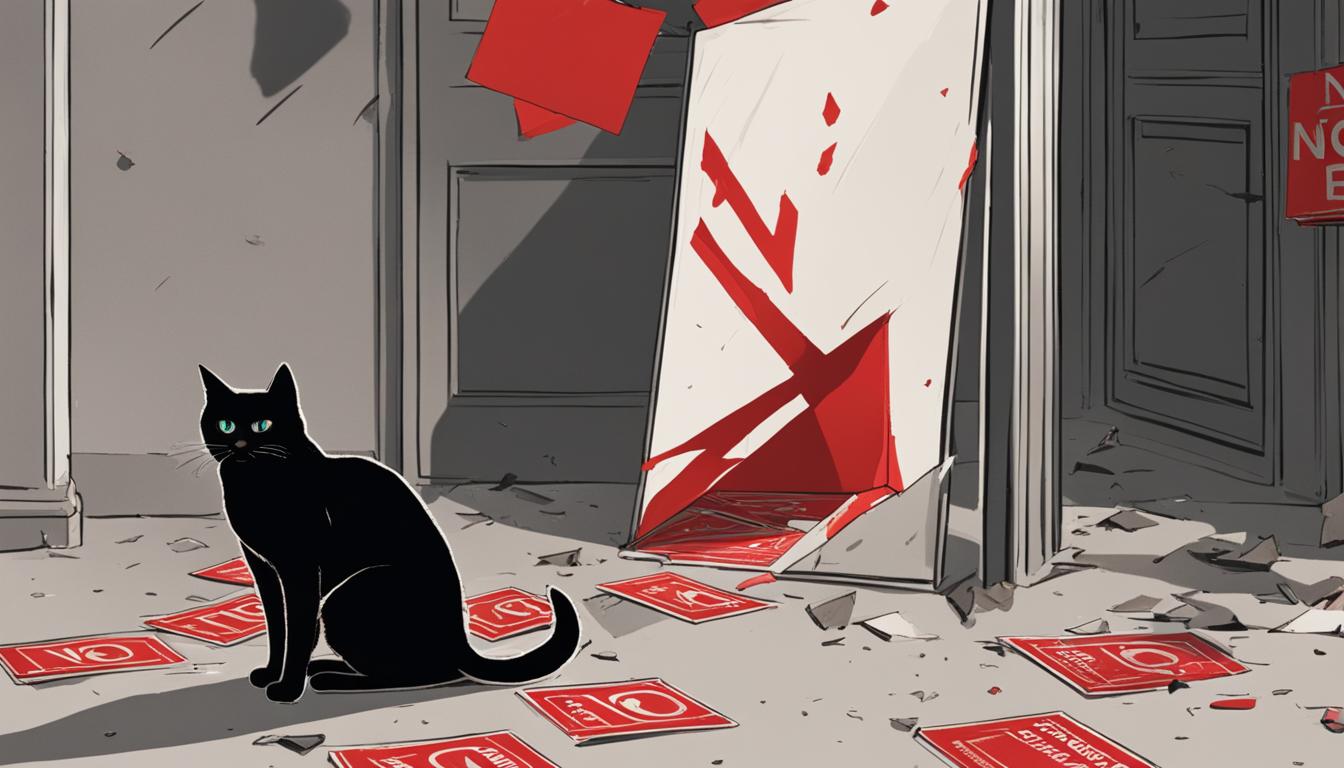Reusing red envelopes during Lunar New Year celebrations has been a subject of debate. Some believe it brings bad luck, while others see it as an environmentally friendly option. Let’s dive into the cultural beliefs and superstitions surrounding the reuse of red envelopes during this auspicious time.
Key Takeaways:
- Reusing red envelopes is a controversial topic during Lunar New Year celebrations.
- Cultural beliefs and superstitions play a significant role in determining whether it is considered bad luck or not.
- There are dos and don’ts associated with reusing red envelopes to avoid any negative consequences.
- Red envelopes hold cultural and emotional value beyond superstitions and environmental considerations.
- The future of red envelopes may be influenced by digitization but their cultural significance is likely to endure.
The Significance of Red Envelopes in Superstitions and Culture

Red envelopes, also known as hong baos, hold a special place in Chinese culture and superstitions. They are believed to bring luck, prosperity, and blessings. Receiving and giving them during the Lunar New Year is a way to spread good fortune to loved ones. However, there are certain rules and beliefs associated with red envelopes that should be followed to ensure positive energy and avoid bad luck.
According to Chinese cultural beliefs, red envelopes symbolize the transfer of wealth and good wishes. The color red is considered auspicious and is believed to ward off evil spirits. The money inside the envelope is seen as a gift of fortune, representing the sender’s well wishes for the recipient’s success and prosperity in the new year.
Omens are also associated with the act of reusing red envelopes. It is believed that using a torn or damaged red envelope can bring bad luck, as it may symbolize a loss of wealth or fortune. Similarly, giving an empty red envelope is considered an ill omen, signifying the absence of blessings. It is important to handle red envelopes with care and ensure they are in good condition.
“The tradition of giving and receiving red envelopes is deeply rooted in our culture. It is a way to bestow blessings and good fortune upon family and friends,” says Master Lim Eng Cheong, an expert in Chinese culture.
| Cultural Beliefs | Meanings |
|---|---|
| Red Color | Auspicious, symbolizes good luck and wards off evil spirits |
| Money | Transfer of wealth and well wishes for prosperity |
| Torn or Damaged Envelopes | Associated with loss of wealth and bad luck |
| Empty Envelopes | Considered an ill omen, absence of blessings |
In summary, red envelopes play a significant role in Chinese culture and superstitions. They carry blessings, good fortune, and wishes for a prosperous new year. While reusing red envelopes is a common practice, it is important to handle them with care and avoid using torn or damaged envelopes. By adhering to these cultural beliefs, one can ensure the positive energy and symbolism associated with red envelopes are preserved.
Dos and Don’ts of Reusing Red Envelopes

When it comes to reusing red envelopes, there are some important guidelines to follow in order to avoid any negative consequences or bad luck. These dos and don’ts have been shaped by centuries of cultural beliefs and superstitions surrounding red envelopes during Lunar New Year celebrations.
Dos:
- Use even numbers: According to Master Lim Eng Cheong, an expert in Chinese culture, it is considered auspicious to use even numbers when reusing red envelopes. Odd numbers are associated with funerals and are therefore considered inappropriate for this joyous occasion.
- Choose appropriate designs: The design on the red envelope should be suitable for the Lunar New Year. It should reflect the festive spirit and traditional symbols such as flowers, fish, or the Chinese character for luck.
Don’ts:
- Avoid the number four: In Chinese culture, the number four is considered unlucky as it sounds similar to the word for death. It is best to avoid using red envelopes with the number four or any derivatives of it.
- Don’t feature the wrong Zodiac animal: Each year is associated with a different Zodiac animal, and it is important to ensure that the design on the red envelope matches the current year’s animal. Using the wrong Zodiac animal can be seen as inauspicious.
By following these dos and don’ts, you can uphold the cultural traditions and beliefs associated with red envelopes while avoiding any inadvertent missteps that may lead to negative consequences or bad luck.
The Traditional Art of Giving and Receiving Red Envelopes

Red envelopes have deep cultural significance in Chinese traditions and are also found in various other cultures. The act of giving and receiving red envelopes is a time-honored practice that symbolizes blessings, good wishes, and unity. During Lunar New Year celebrations, red envelopes are exchanged to spread prosperity and happiness among loved ones.
When giving a red envelope, it is customary to present it with both hands as a sign of respect and gratitude. The recipient accepts the envelope and expresses appreciation for the well wishes contained inside. It is important to note that opening the envelope immediately or in the presence of the giver is considered impolite. Instead, it is customary to wait until returning home before opening the red envelope.
While red envelopes hold great cultural significance, they are not limited to Chinese culture. In many other cultures, red envelopes are used to celebrate festive occasions and auspicious events. They may have different names and variations in symbolism, but the overall meaning of spreading good fortune and blessings remains the same.
The Symbolic Meaning of Red Envelopes in Different Cultures
In Chinese culture, red envelopes symbolize good luck, prosperity, and protection against evil spirits. They are believed to ward off negative energy and bring blessings to the recipient. Red is considered an auspicious color associated with happiness and joy. The act of giving and receiving red envelopes during Lunar New Year celebrations strengthens family bonds and fosters a sense of unity.
In other cultures, red envelopes also hold special significance. For example, in Korean culture, red envelopes called “bok jumeoni” are given during important occasions like weddings, birthdays, and New Year celebrations. In Vietnamese culture, red envelopes known as “li xi” are exchanged during Tet, the Vietnamese New Year. These envelopes symbolize best wishes for the recipient’s health, wealth, and happiness.
The meaning behind red envelopes may vary across cultures, but the underlying sentiment of spreading good fortune and blessings remains a common thread. The exchange of red envelopes not only brings joy and prosperity to individuals but also strengthens cultural traditions and fosters a sense of community.
Environmental Consciousness and Red Envelopes

As society becomes increasingly aware of the need for environmental sustainability, the question arises about the practice of reusing red envelopes. While it may seem like a practical and eco-friendly choice, it is important to consider the cultural beliefs and significance attached to these festive envelopes.
In many cultures, red envelopes symbolize good luck, prosperity, and blessings. The act of giving and receiving them during Lunar New Year celebrations is deeply rooted in tradition and carries a special meaning. The belief is that the money inside the envelope carries positive energy and bestows good fortune upon the recipient. To reuse a red envelope, especially one that has already been used in a previous year, can be seen as a lack of awareness or ignorance about the symbolism associated with the new year.
Experts advise using new envelopes to maintain the positive energy and respect the cultural traditions surrounding red envelopes. While recycling and reusing materials is commendable in many aspects of daily life, it is important to be mindful of the cultural significance attached to certain practices. By using new red envelopes, individuals can show their respect for tradition and maintain the positive energy associated with this cherished custom.
| Pros of Reusing Red Envelopes | Cons of Reusing Red Envelopes |
|---|---|
|
|
Ultimately, the decision to reuse or use new red envelopes is a personal one. It is important to weigh the environmental benefits against the cultural considerations and significance attached to this longstanding tradition. By being mindful of the cultural beliefs and traditions surrounding red envelopes, individuals can ensure that their Lunar New Year celebrations are filled with positivity, respect, and good fortune.
Recycle Programs for Red Envelopes

In recent years, the concern for the environment has led to the emergence of red envelope recycling programs. These programs aim to address the challenge of waste generated from the traditional practice of using new red envelopes each year. One notable example is the Lai See Reuse and Recycle Program initiated by Greeners Action in Hong Kong since 2010.
The Lai See Reuse and Recycle Program has been successful in collecting and recycling millions of red envelopes, effectively saving thousands of trees. By participating in these recycling initiatives, individuals can contribute to both environmental conservation and cultural respect, recognizing the significance of red envelopes while minimizing waste.
These recycling programs also present an opportunity to educate the public about the cultural beliefs and customs associated with red envelopes. By raising awareness and understanding, individuals can make informed choices that respect both the environment and the cultural significance of red envelopes during Lunar New Year celebrations.
Modern Trends in Red Envelope Traditions

In the digital age, the tradition of giving red envelopes is evolving. As technology advances, electronic red envelopes, or e-lai-see, are becoming more popular, especially during the COVID-19 pandemic when social distancing is encouraged. These digital versions of red envelopes allow people to send monetary gifts to their loved ones electronically, spreading good fortune and well wishes without physical contact.
However, despite the rise of e-lai-see, many still prefer the traditional practice of giving physical red envelopes. The act of face-to-face gifting holds symbolic meaning, representing the personal connection and care between the giver and recipient. The exchange of physical red envelopes also provides a tangible and cherished memory of the occasion.
Furthermore, the younger generation is finding innovative ways to repurpose red envelopes for art and crafts. By transforming red envelopes into decorative items or incorporating them into creative projects, they bridge the gap between tradition and modernity, showcasing the cultural significance of red envelopes in a contemporary context.
In summary, while electronic red envelopes are gaining popularity, the traditional practice of giving physical red envelopes remains significant. Whether it’s through digital means or physical exchange, red envelopes continue to carry the cultural value of blessings and good wishes, nurturing connections and fostering a sense of community.
The Legal Aspects of Red Envelope Giving

When it comes to red envelope giving, there are legal aspects that should be considered to avoid any potential disputes. While red envelopes are traditionally given as a gesture of goodwill and blessings, problems can arise when it comes to the management of the money inside. It is important to understand the ownership and rights associated with red envelope money to ensure a smooth and respectful exchange.
According to legal rulings, red envelope money belongs to the recipient, regardless of their age. This means that parents or guardians are not allowed to use the money without the child’s consent. While parents can help manage the funds on behalf of the child, it is crucial to respect their ownership and not misuse the money. This legal perspective emphasizes the significance and value placed on red envelope giving.
By honoring the legal aspects of red envelope giving, we can uphold the cultural traditions and respect the intentions behind this cherished practice. Red envelopes are a symbol of love, respect, and good fortune, and it is essential to ensure that their exchange is carried out in a responsible and lawful manner.
Table: Legal Aspects of Red Envelope Giving
| Legal Rule | Explanation |
|---|---|
| Recipient Ownership | The money inside the red envelope belongs to the recipient, regardless of their age. |
| Parental Involvement | Parents can help manage the funds but cannot use the money without the child’s consent. |
| Respect for Tradition | By following the legal aspects, we can uphold the cultural significance of red envelope giving. |
Understanding the legal aspects of red envelope giving ensures that the exchange of blessings and good fortune is carried out in a respectful and lawful manner. It highlights the importance of ownership and respect for the cultural traditions associated with red envelopes.
The Future of Red Envelopes
As society and traditions evolve, the future of red envelopes remains uncertain. While digitization and changing attitudes towards gift-giving may impact the tradition, the cultural significance and symbolism attached to red envelopes are likely to endure. Red envelopes serve as a symbol of blessings and good wishes, connecting generations and fostering a sense of community.
Chinese cultural beliefs on red envelopes emphasize the importance of maintaining traditions and respecting the symbolism associated with them. The act of giving and receiving red envelopes during Lunar New Year is deeply rooted in cultural practices and carries emotional value. It represents love, respect, and well wishes for the recipient, strengthening family bonds and fostering unity.
However, with the rise of environmental consciousness, the question arises about the sustainability of red envelopes. Reusing red envelopes is seen as a way to reduce waste and minimize the environmental impact. On the other hand, cultural beliefs caution against reusing red envelopes as it may be seen as a lack of awareness or ignorance about the significance of the new year.
“Red envelopes symbolize blessings and prosperity. They carry good fortune and are meant to be given and received with respect. While the future of red envelopes may adapt to modern trends, it is crucial to balance environmental concerns with cultural beliefs,”
explains Master Lim Eng Cheong, an expert in Chinese culture.
As we move forward, the future of red envelopes may involve finding a middle ground that balances cultural traditions with environmental considerations. Perhaps there will be eco-friendly alternatives or digital advancements that still capture the essence of red envelopes while reducing waste. Whatever the future holds, the cultural and emotional value of red envelopes will continue to play a significant role in Lunar New Year celebrations and beyond.
Cultural Beliefs on Reusing Red Envelopes
Chinese cultural beliefs regarding red envelopes vary across regions and households. Some families adhere strictly to traditional customs, while others embrace modern changes. It is important to approach the topic with cultural sensitivity and respect, understanding that beliefs and practices may differ from person to person and family to family.
The Cultural and Emotional Value of Red Envelopes
Beyond the superstitions and environmental considerations, red envelopes hold a cultural and emotional value. They represent love, respect, and good fortune. The act of giving and receiving red envelopes strengthens family bonds and cultivates a sense of unity during festive occasions. In a fast-paced world, red envelopes serve as a reminder of tradition, gratitude, and the importance of cherishing cultural practices.
Red envelopes have deep-rooted cultural beliefs surrounding them, making them more than just a monetary gift. The exchange of red envelopes symbolizes blessings and good wishes. It is a way for the older generation to pass down their well wishes and bestow blessings upon the younger generation. The act of receiving a red envelope also fosters a sense of gratitude and appreciation for the giver.
“The tradition of giving and receiving red envelopes during Lunar New Year is a cherished practice that brings communities together,” says Master Lim Eng Cheong, an expert in Chinese culture. “It represents a cultural connection that transcends generations and serves as a reminder of the importance of family and unity.”
The emotional value of red envelopes extends beyond cultural boundaries. They hold significance in various other cultures during festivals and auspicious occasions. Red envelopes have become a way to express love, gratitude, and well wishes globally. Whether it is the traditional physical red envelopes or the modern digital red envelopes, the emotional connection and sentiment remain the same.
Table: Cultural Beliefs on Reusing Red Envelopes
| Myths About Reusing Red Envelopes | Cultural Beliefs |
|---|---|
| Reusing red envelopes brings bad luck | Red envelopes should be used for giving blessings and spreading good fortune |
| Reusing red envelopes shows a lack of respect for traditions | Using new red envelopes maintains the positive energy and respect for cultural practices |
| Reusing red envelopes may invite negative consequences | Using fresh red envelopes ensures the avoidance of any potential negative outcomes |
The cultural and emotional value of red envelopes goes beyond the materialistic aspect. It carries the weight of tradition, love, and unity. Red envelopes serve as a timeless reminder of the importance of cherishing cultural practices and fostering connections among family and friends.
Conclusion
The question of whether it is bad luck to reuse red envelopes is subjective and rooted in cultural beliefs and superstitions. While there is no definitive answer, it is important to consider the cultural significance and symbolism associated with red envelopes before deciding to reuse them.
Whether you choose to adhere to tradition or prioritize environmental consciousness, the act of giving and receiving red envelopes during Lunar New Year is a cherished practice that fosters love, unity, and good wishes for all.
So, next time you come across a red envelope, take a moment to appreciate the cultural beliefs and the blessings it represents. Whether it’s the joy of receiving or the happiness of giving, red envelopes hold a special place in our hearts and connect us to our cultural heritage. So, let’s treasure this tradition and continue to spread good fortune, happiness, and prosperity to our loved ones.
FAQ
Is it bad luck to reuse red envelopes?
The belief surrounding the reuse of red envelopes varies. Some consider it bad luck, while others see it as an environmentally friendly option.
What is the significance of red envelopes in superstitions and culture?
Red envelopes are believed to bring luck, prosperity, and blessings. They are given and received during Lunar New Year celebrations as a way to spread good fortune to loved ones.
What are the dos and don’ts of reusing red envelopes?
It is important to use even numbers and avoid the number four, as it is associated with death. The design on the red envelope should be appropriate for the Lunar New Year, and it should not feature the wrong Zodiac animal.
What is the traditional art of giving and receiving red envelopes?
Red envelopes are a traditional practice during Lunar New Year celebrations. The amount of money inside symbolizes well wishes for the recipient, and it is customary to accept the envelope with both hands and express gratitude.
What is the environmental consciousness surrounding red envelopes?
Reusing red envelopes can be seen as a lack of awareness or ignorance about the Lunar New Year traditions and symbolism. However, some organizations have started red envelope recycling programs to address environmental concerns.
Are there any recycle programs for red envelopes?
Yes, organizations like Greeners Action in Hong Kong have been running red envelope recycling programs since 2010. These programs have collected and recycled millions of red envelopes, contributing to both environmental conservation and cultural respect.
What are the modern trends in red envelope traditions?
In the digital age, electronic red envelopes or e-lai-see are becoming more popular, especially during the COVID-19 pandemic. However, many still prefer physical red envelopes as they carry symbolic meaning and allow for face-to-face gifting.
What are the legal aspects of red envelope giving?
Red envelope money belongs to the recipient, regardless of their age. Parents can help manage the money but cannot use it without the child’s consent, highlighting the importance of respecting ownership and cultural significance.
What does the future hold for red envelopes?
While traditions may evolve, the cultural significance and symbolism attached to red envelopes are likely to endure. Red envelopes serve as a symbol of blessings and good wishes, connecting generations and fostering a sense of community.
What is the cultural and emotional value of red envelopes?
Red envelopes represent love, respect, and good fortune. The act of giving and receiving strengthens family bonds and cultivates unity during festive occasions. They serve as a reminder of tradition, gratitude, and the importance of cherishing cultural practices.
Source Links
- https://sg.style.yahoo.com/hong-bao-dos-donts-according-fengshui-experts-044417878.html
- https://www.scmp.com/yp/discover/lifestyle/article/3208732/red-goes-green-environmental-group-says-you-should-reuse-lunar-new-year-red-envelopes-send
- https://www.chinadaily.com.cn/a/201902/19/WS5c6b4084a3106c65c34e9fc3.html

